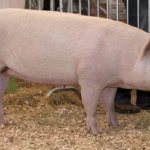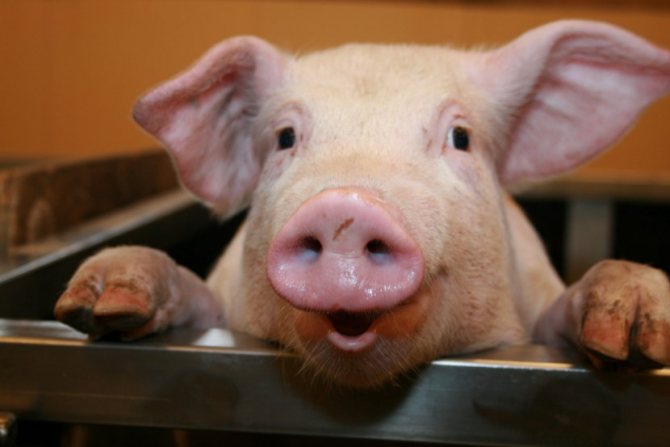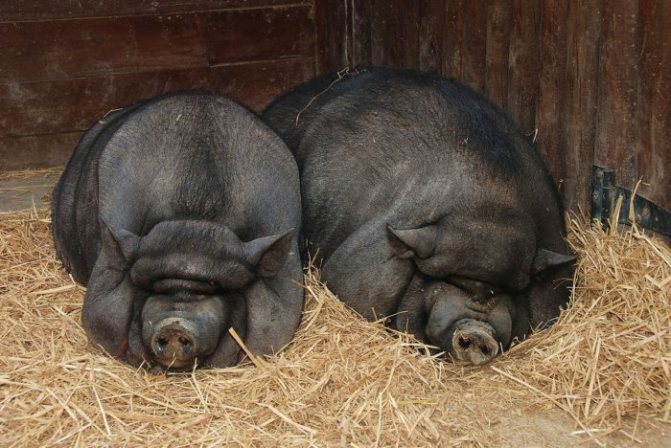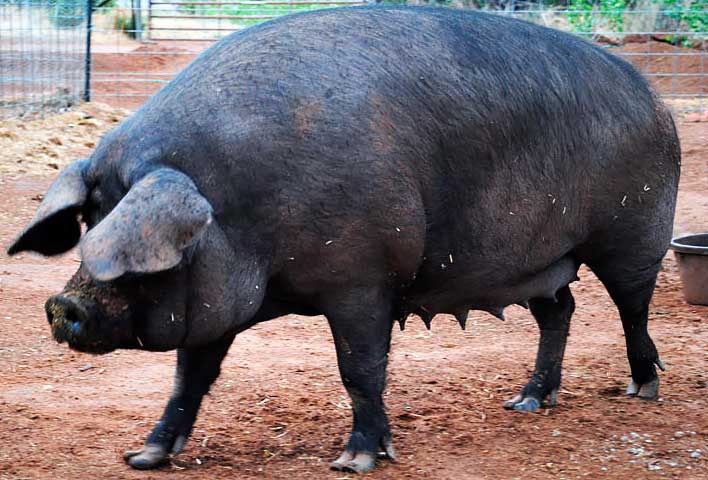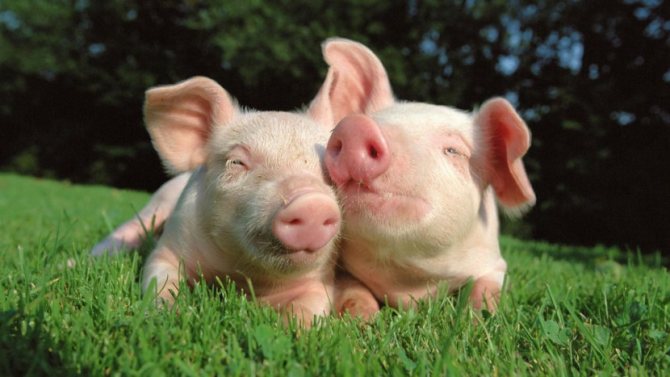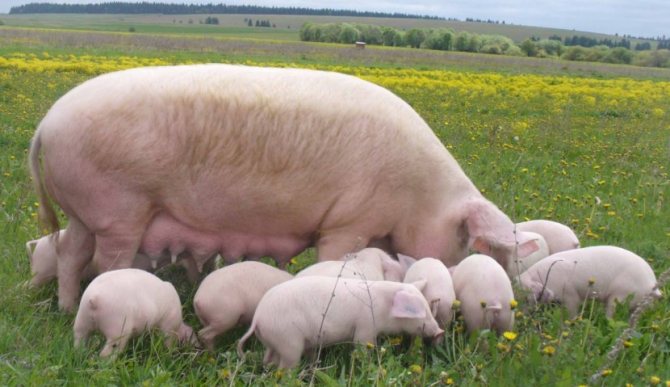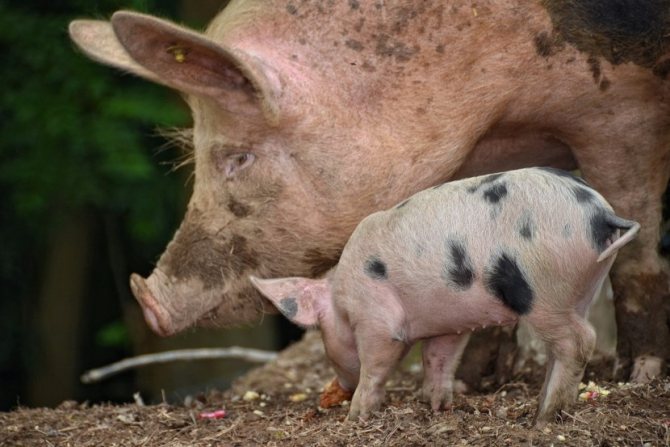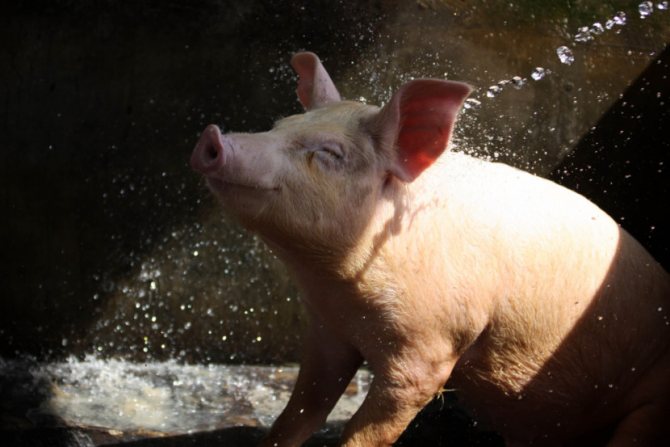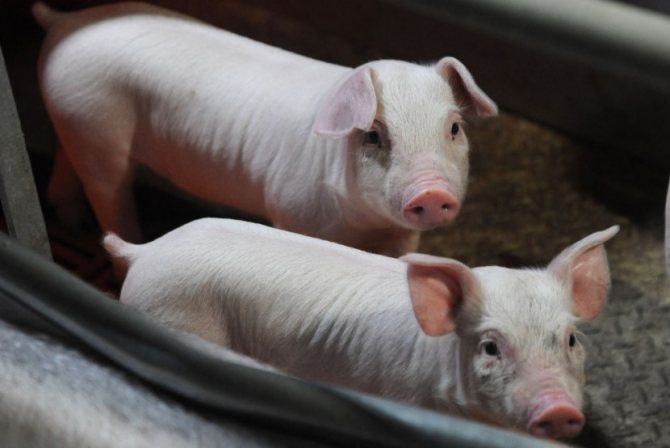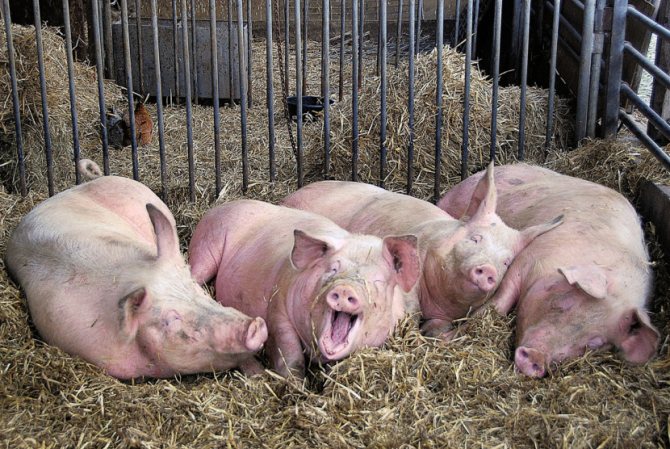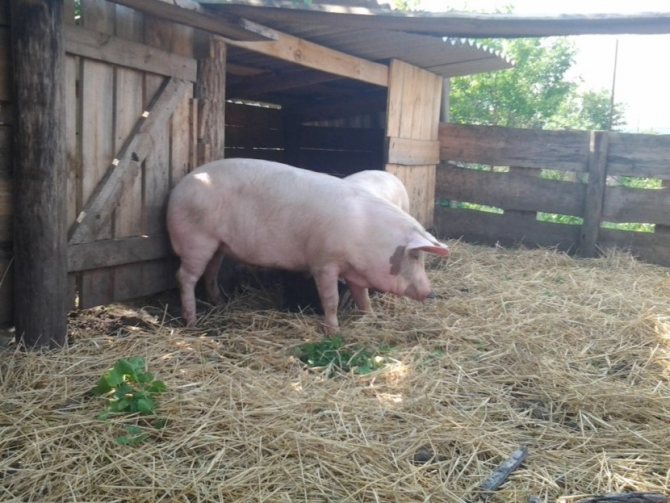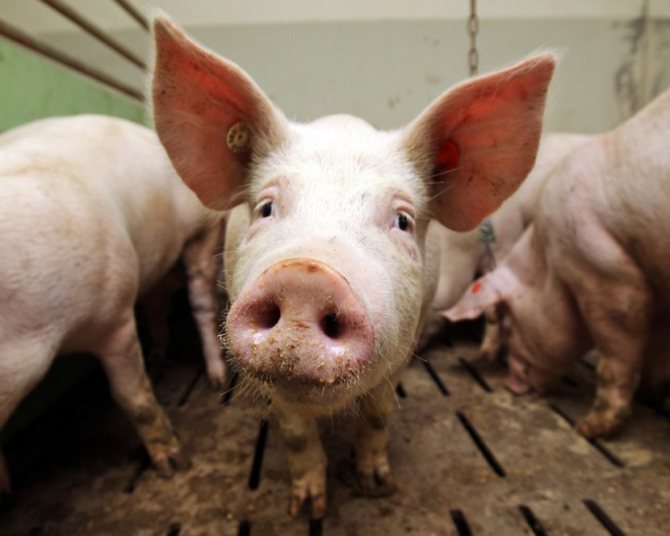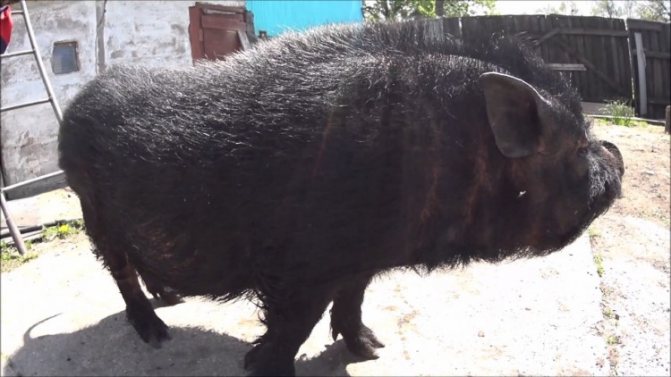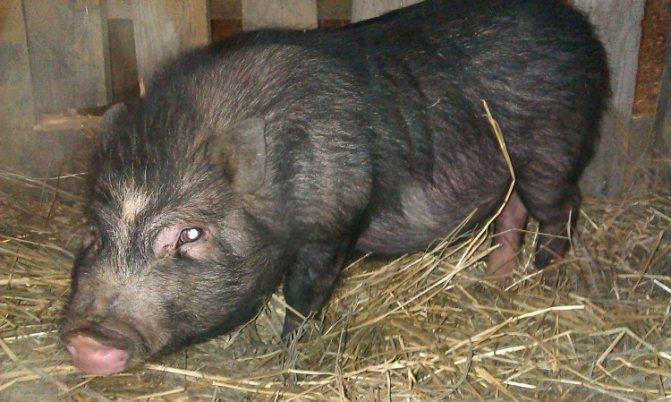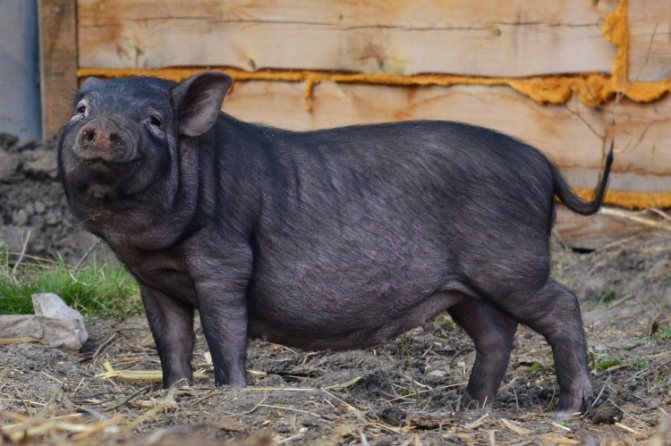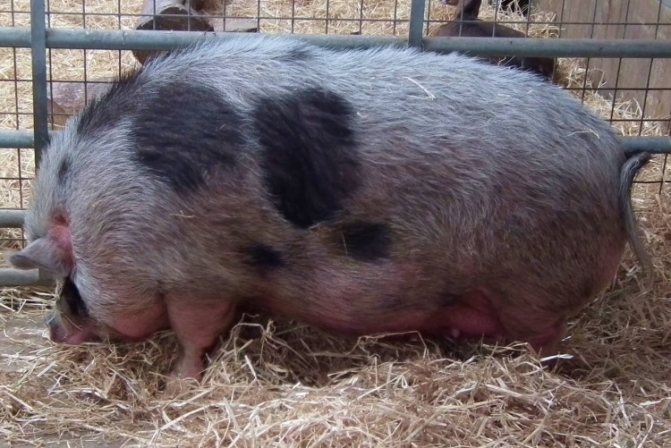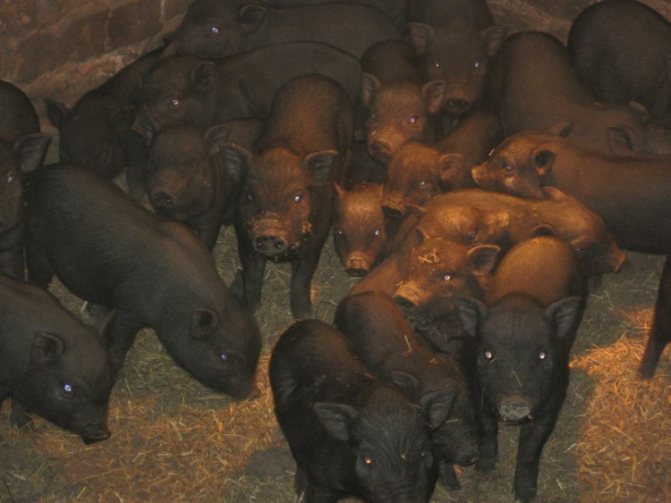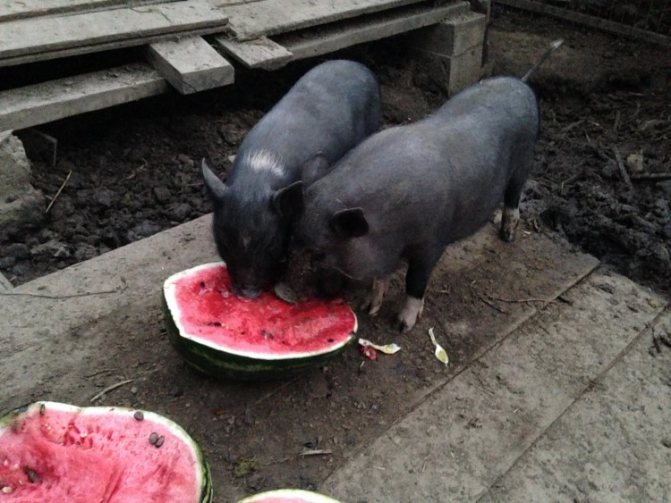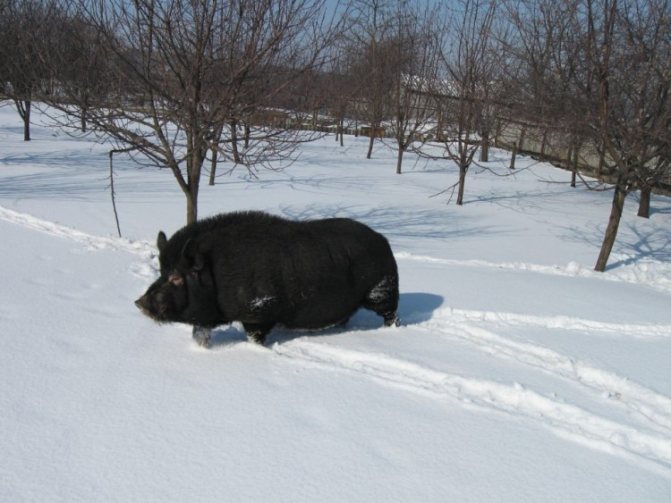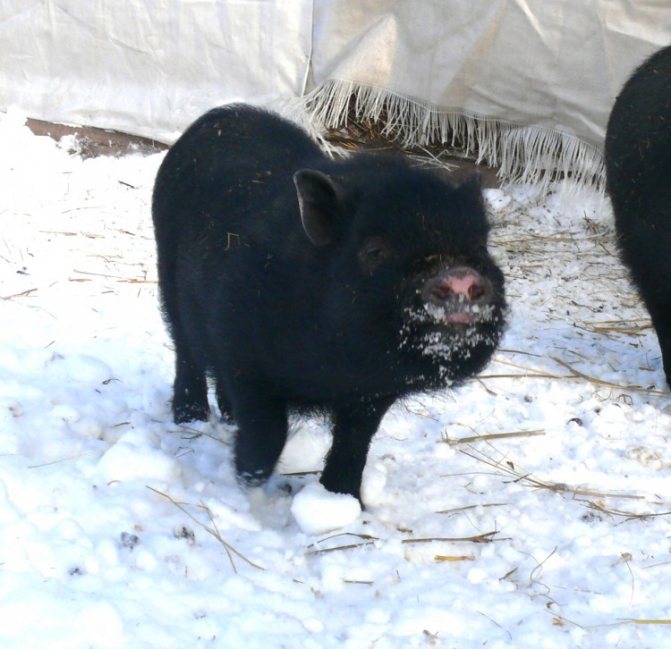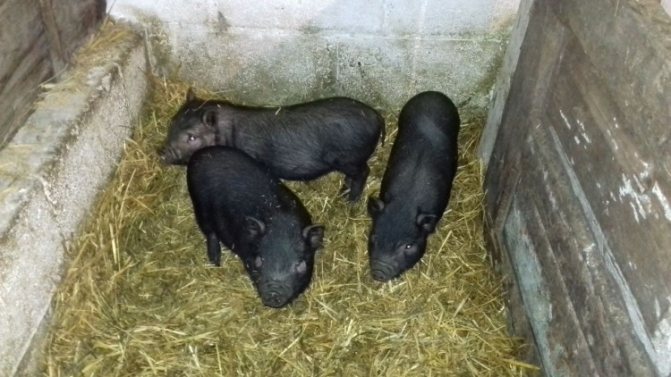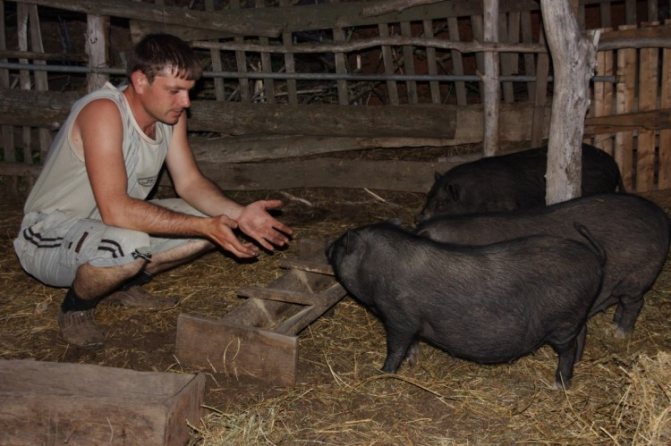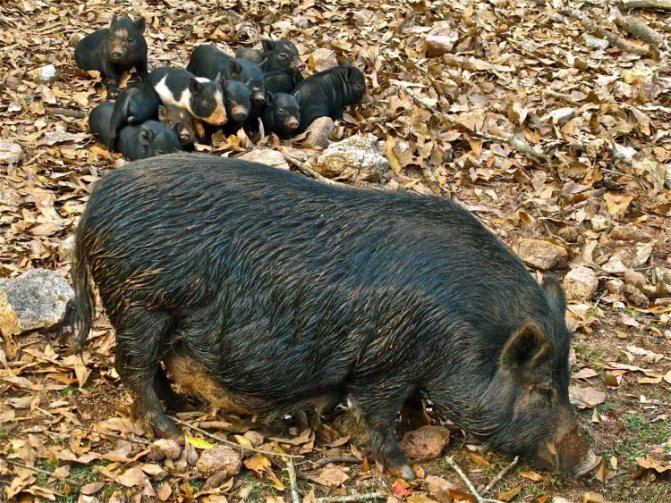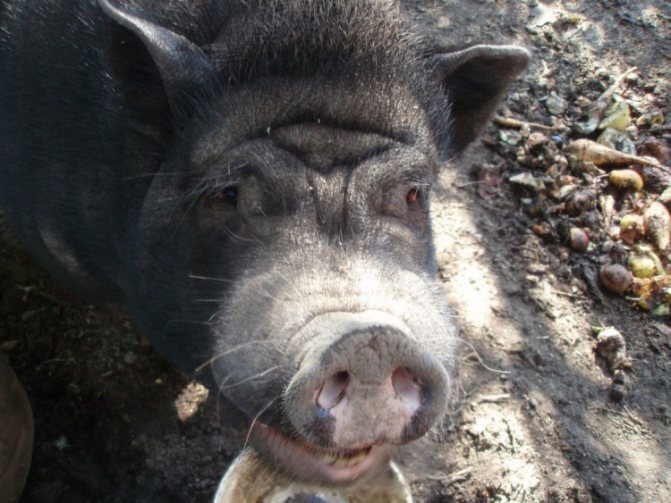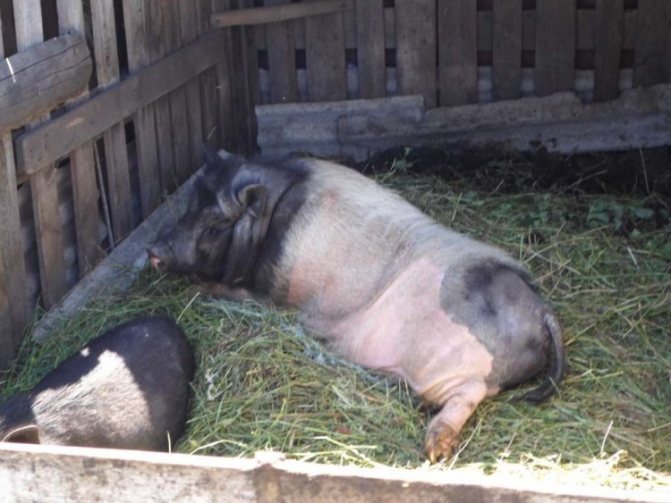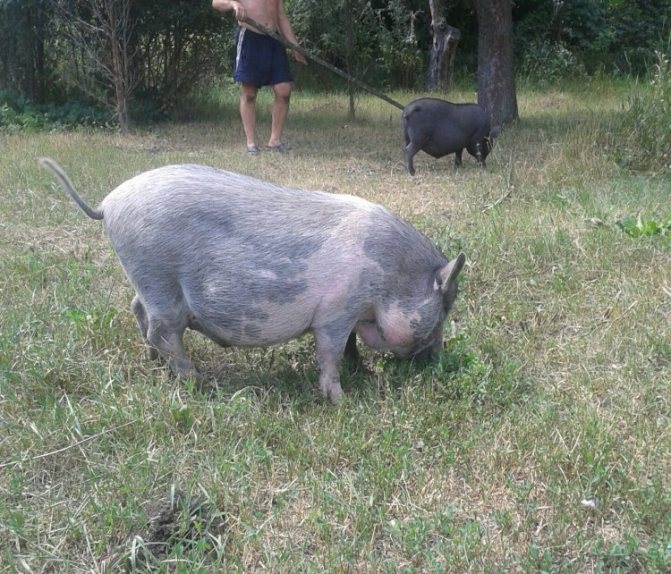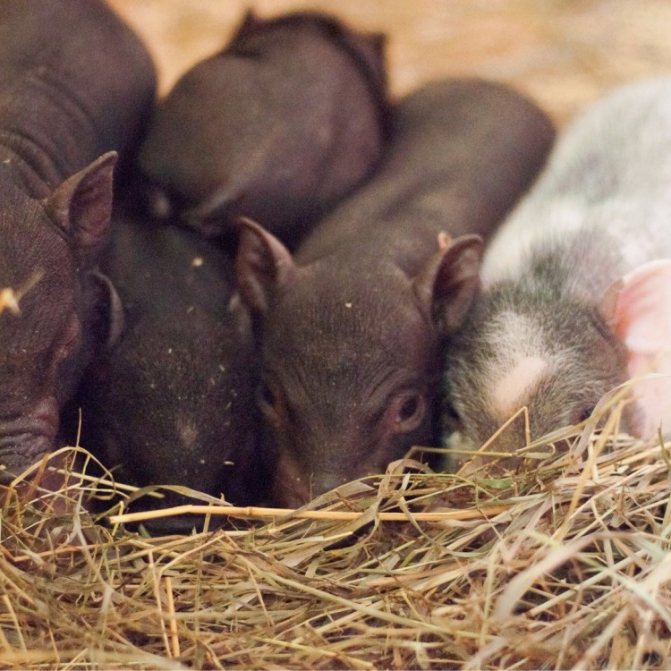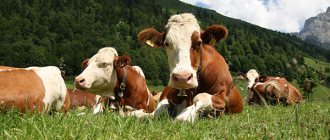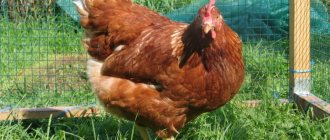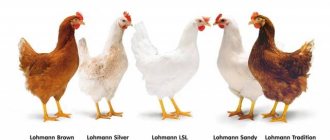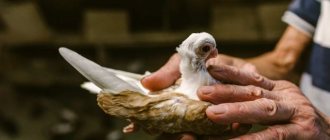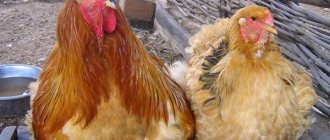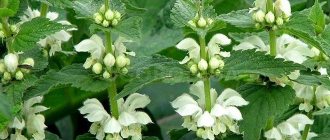The origin of the breed of pigs large white
The birthplace of the breed is England. Long-eared pigs were originally bred on the island, which were gradually improved by the method of simple selection and creation of improved housing conditions. So over time, the Leicester pig was bred.
In the 19th century, the rate of improvement of English pigs accelerated significantly. Local pigs, including Leyster, began to be crossed with representatives of foreign breeds. This work was carried out in a decentralized manner at once in many livestock farms, often without a specific goal and adherence to methodology. As a result, many very diverse quasi-breed groups with unstable heredity have emerged.

In the early 1830s. one of the British cattle breeders managed to breed a stable breed of early maturing, but small pigs. The breed was named small white. Due to the high exactingness of these pigs to the conditions of keeping, they were not widely spread, and the farmers soon lost interest in them altogether. However, this breed managed to contribute to the improvement of English pigs. In 1851, a cross between long-eared Leyster and small white pigs was presented at an agricultural exhibition. These were early maturing animals with good meat characteristics and excellent fertility, undemanding to the conditions of keeping.
This successful cross, called the Yorkshire pig, quickly gained popularity among English breeders. To prevent the threat of degeneration of the breed in 1885, a single standard was developed and a studbook was established. From that moment on, the breed was officially called "large white pig".
In Russia, as in other European countries, the breed began to be exported in the 1880s. But these animals could not influence the general situation in Russian pig breeding at that time. The wars of the beginning of the century, coupled with economic devastation, led to the almost complete loss of English breeding pigs in Russia.
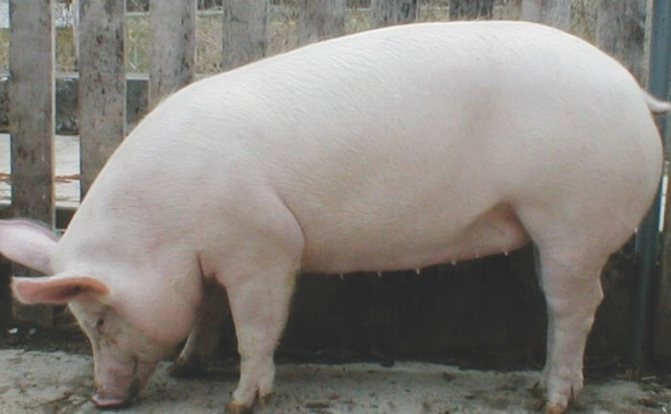

After the stabilization of the political situation in Soviet Russia, a program was launched to create a state-owned pig-breeding industry. As part of this process in the 1920s. More than 600 breeding pigs were imported from Great Britain, which became the basis for the creation of the Soviet livestock of breeding domestic pigs.
After the purchase of English animals in the USSR, work began to further improve this breed. Over the decades of selection and crossbreeding, a new breed has been created, by and large, although in practice it is still referred to simply as a large white pig. Meanwhile, today Russian pigs differ from their English relatives in a more massive constitution and fertility, not to mention adaptability to domestic climatic conditions.
In Soviet times, breeders worked partly to improve the greasy qualities of pigs, so the proportion of meat-type individuals in the breed decreased. After the collapse of the USSR, the structure of consumer demand has changed, so today breeders are working to improve the meat qualities of white pigs.
According to experts, today the large white breed of pigs makes up 80% of the domestic livestock.Moreover, most of the other breeds bred in the Russian Federation, to one degree or another, also contain genes of the large white breed.
How many heads can you start a business with piglets?
Many novice farmers are primarily interested in this question. But no one will answer you for sure. After all, it all depends on the capabilities and volume of financial investments. You can start from scratch with a couple of dozen pigs, gradually expanding the farm.
According to the experience of many farmers, the optimal livestock from which to start a pig business is 300-400 individuals. Here you should also take into account the next point - product sales. It is this question that needs to be studied before starting to purchase piglets.
An important point! Females and males should be purchased from different nurseries or farms. This will avoid family ties and possible genetic mutations.
Large white pig breed - description
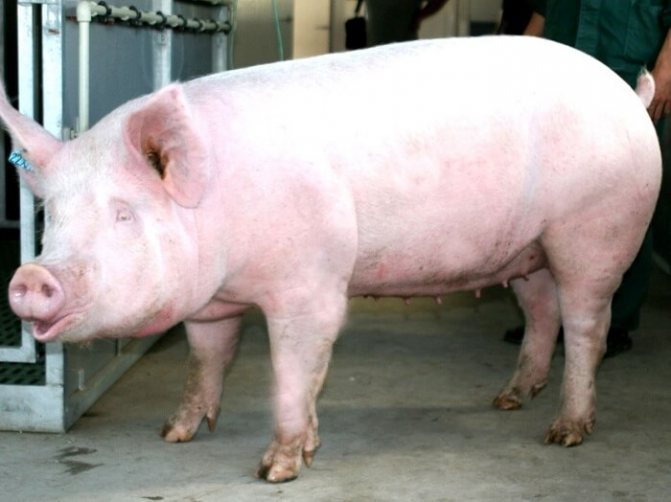

This breed is classified as universal, that is, meat-greasy, which is also evident in its exterior. Animals have a strong constitution, but at the same time they have a slightly delicate body.
With a rather massive body, the head is small with a moderately wide forehead and a not very long snout. The ears are large, but not drooping.
The body is oblong and wide, connected to the head by a long, wide neck. The back is straight, sometimes slightly curved upward. The hams are almost perfectly shaped. The ribs are rounded, the belly is tucked up, not pendulous.
The skin has a classic light pink (pig) color, which is also classified as white. The bristles are fine but dense.
The character of the white pig is calm and even phlegmatic.
Rare
Of course, if a domestic farmer wants to have black pigs on his land, in most cases he will choose from the varieties presented above. They have a lot of advantages. However, those who want to purchase truly rare breeds of black pigs should pay attention to the following specimens. If you wish, check the information about them on Wikipedia.
Nero di Parma, or Nero Parmesan
This representative belongs to the Italian Aboriginal breed, which is bred exclusively for meat products. Among the key advantages of the species is good resistance to low temperatures. In the middle of the last century, this breed of meat pigs significantly reduced its number, since productive white relatives began to be actively imported into Italy.
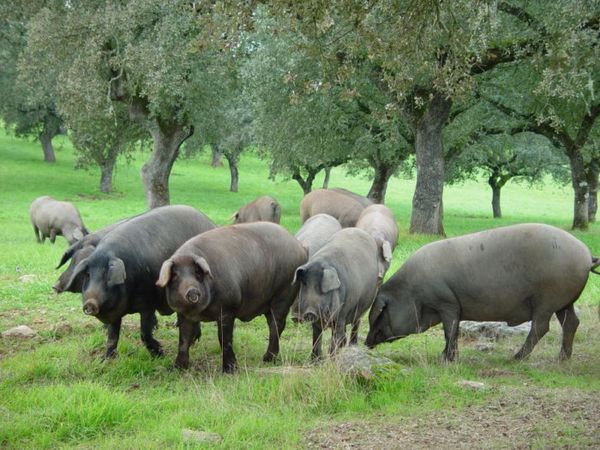

However, after many years of work on the restoration of the breed, these gilts can again be purchased for breeding. Those who wish to raise these animals on their farm should take into account the fact that they are characterized by good fertility (one brood includes about 10 piglets).
Guinea pig
This large black piglet is bred primarily in the United States, although it has African roots. The animal is large in size, and also has neat erect ears. Small pigs weigh no more than half a kilogram (when born). With regard to nutrition, such individuals can safely get by with grass, and they also catch snakes. This variety is considered small in number, since it is not particularly popular among farmers.
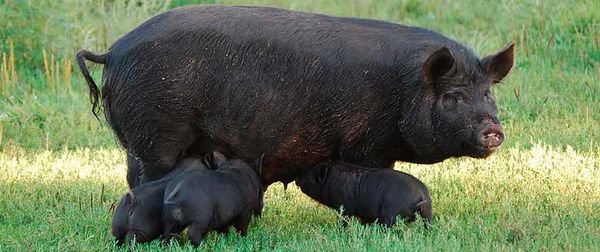

Black iberian pig
Most of these pigs are bred in Portugal and Spain. Animals have an elongated body, on which hair is almost completely absent. Long legs and rather hard hooves are a characteristic feature of the species. Their appetite is always good, so it is necessary to provide them with a balanced diet. Otherwise, pigs can be obese.
Among the key characteristics of the breed, it is also worth highlighting the genetic feature - the marbling of the meat. That is, the fat is, as it were, distributed between the fatty fibers.The taste of the meat product is excellent, since pigs spend a lot of time on pastures. Choose a species for breeding that suits you specifically, and take into account the basic recommendations for raising large animals. In this case, you can count on a high percentage of meat in the output.
Large white breed of pigs - a characteristic of productivity
White pigs are characterized by excellent early maturity. They are capable of gaining 700 g of weight per day. The young growth, optimal for slaughter, gains 100 kg of weight on 180 days of life. The feed conversion is about 4 kg feed units per kg weight gain.
At the age of 12 months, the pig weighs in the range of 200 kg. Adult sows can reach 230-250 kg, boars - 300-350 kg.
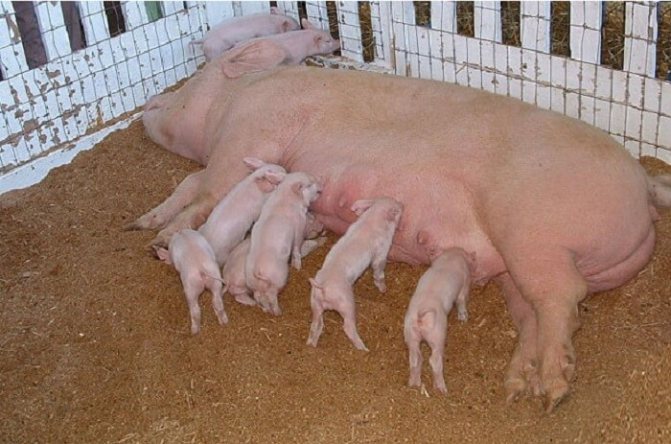

Slaughter yield of young animals is 80-82%. Moreover, the meat has excellent taste characteristics. Due to the fact that the muscle fibers of the white pig are permeated with a network of thin layers of fat, the meat is very juicy and soft.
Among the most important characteristics of the large white breed of pigs, good fertility should also be attributed. A sow brings on average 11-12 piglets, and sometimes all 14.
Maintenance and diet of a large white pig
Although white pigs can hardly be called capricious, some of their characteristics should be remembered. Due to the delicate white skin and minimal hairline, these animals very poorly tolerate both direct sunlight in hot weather and more or less severe frost. For this reason, during summer walks in the fresh air, they need to provide protection from the sun in the form of a light canopy or just shade from the trees. In winter, walking should be limited in time, depending on the air temperature.
For the rest, the content of white pigs does not fundamentally differ from the standard recommendations for this type of farm animals. Piggy need a warm, clean pigsty with good ventilation and adequate lighting. In summer, animals should, if possible, spend as much time as possible outdoors. Ideally, they should generally be released into pasture with green meadow grass. However, stall keeping is quite acceptable when using industrial growing methods.
From an early age, pigs need to be provided with intensive five meals a day. Vegetable feeds are best suited: potatoes and other root crops, cabbage leaves, melons, corn, pumpkin. Also, pigs willingly eat fruits (pears, apples) and green herbs (peas, alfalfa, legumes). Be sure to include feed and dairy products in the diet. It is recommended to feed piglets with boiled root crops with the addition of wheat and whey.
When formulating the ration, it is important to ensure that the pigs receive all the necessary vitamins and minerals. This is important not only to reduce the risk of various diseases, but also to increase the productivity of animals.
It is important that pigs have clean drinking water at all times. At the same time, in order to prevent intestinal infections and disorders, it is advisable to prevent drinking water from heating above 20 degrees.
Feeding mammals
Keeping pigs at home requires a quality balanced diet. Animal feed is liquid, wet and dry. Each type of food is assimilated by the pig's body in different ways:
- Liquid food is food that contains at least 75% moisture. It is a homogeneous mass that meets the physiological needs of the pig.
- Wet food is a substance made up of 1 part dry food and 1.5 parts water. Such food is eaten with pleasure by artiodactyls.
- Dry grubs are the most beneficial in many ways. First, they deteriorate much more slowly and are optimal in areas with high air temperatures. Secondly, by eating dry food, animals gain body weight faster.However, when the diet of mammals consists only of unsaturated food, the risk of diseases such as gastritis, ulcers, etc. increases.


Ideally, pig nutrition should include cereals, root vegetables, herbs, hay dust, dairy and meat waste.
Pig feeding should be optimized two months before slaughter.
Advantages and disadvantages of the large white pig breed
The high prevalence of the breed in Russia is the result of an excellent balance of pros and cons that these pigs possess. Without significant advantages over other breeds, it would never have made up 4/5 of the domestic livestock of breeding pigs.
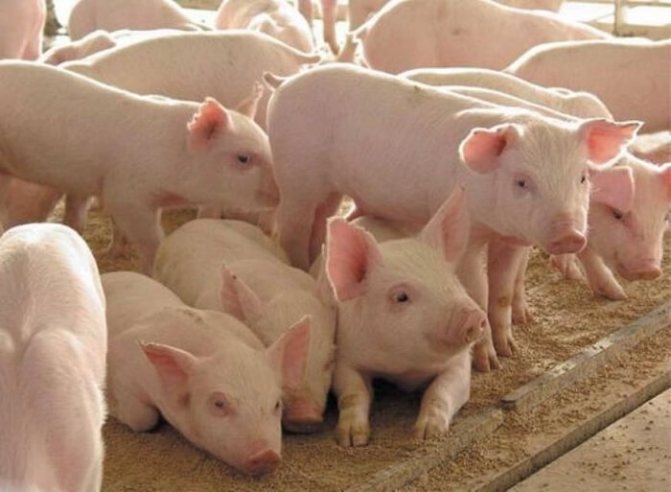

What qualities ensured such popularity for a large white pig? The following factors influenced this most of all:
- Adaptation to domestic conditions. According to the official description, the large white pig breed is excellent for breeding in the conditions of central Russia. Even some sensitivity to sunlight and frost is not a real problem for farmers.
- Unpretentiousness to the diet. Pigs respond well to improved feed quality, but if the farmer is unable to provide a perfectly balanced diet for the pigs, the performance of the animals will not be greatly affected. And there will be no serious health problems either.
- High early maturity. In just 6 months, young growth confidently reaches the bottomhole mass. Thus, the cost of production is lower than that of late-maturing breeds, since gross feed costs are reduced.
- Tasty meat. White pigs produce very high quality "marble" meat, which is in great demand on the food market.
- Fertility. Sows consistently bring 12 piglets each, which allows for very fast growth of livestock with a relatively small broodstock. And this ultimately also reduces the cost of meat products.
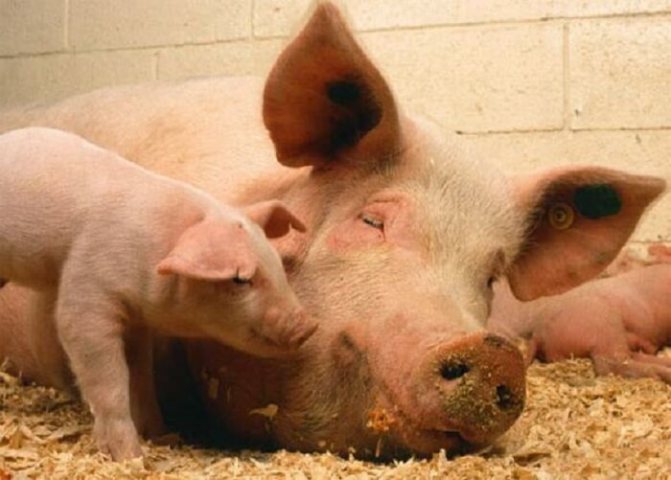

As for the disadvantages of the white breed, they are not so significant:
- Increased fat content. For a long time, Soviet breeders were engaged in increasing the greasiness of the white breed. Nowadays, the demand for lard in Russia is not that great, so the high content of lard has become a disadvantage of the breed.
- Sun and frost intolerance. This peculiarity of the breed is not really a serious problem. But in the southern regions of the country, where it is hot all summer, grazing of pigs on pasture is excluded, where it is impossible for them to provide protection from direct sunlight. In the northern regions, however, it is difficult to provide even short walks in the fresh air during severe frost in winter.
Reproduction
The sow has excellent instincts, so no owner's intervention is required. Females are considered sexually mature as early as 4 months, and pigs by 6 months.
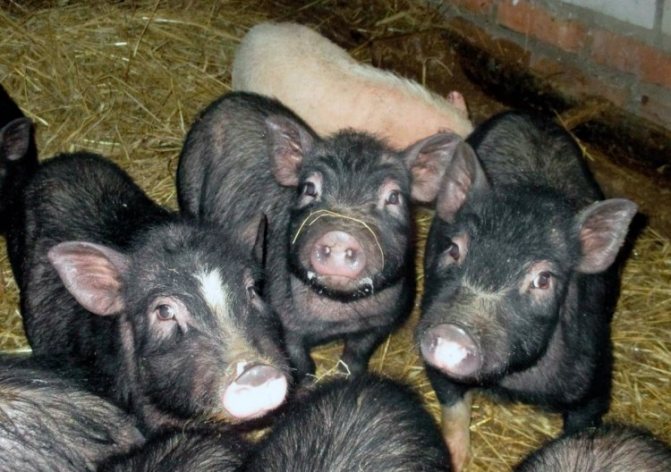

Sows are fertile - up to 18 piglets, but mostly up to 12 babies. In a year, 1 female will bring 24 pigs.


Pigs have excellent genetic memory, they will never eat poisonous plants.


Pigs are economical in food, mainly green food. Piglets should not be kept only on the grass.
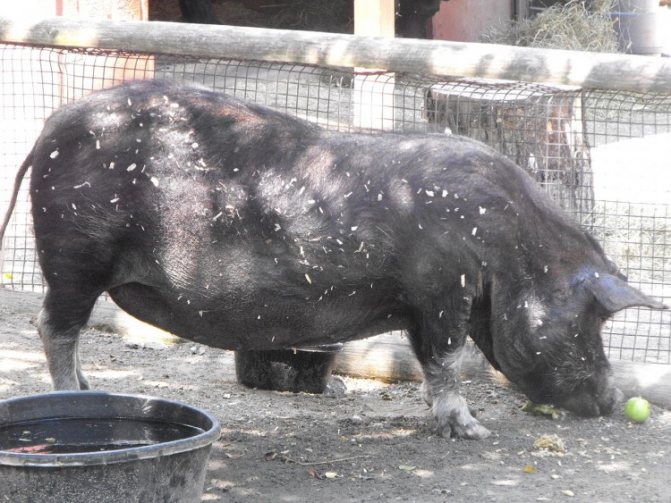

Farrowing thoroughbred Vietnamese pigs is the main stage in animal breeding.


Important! The only requirement is the absence of family ties between the pigs and the boar.
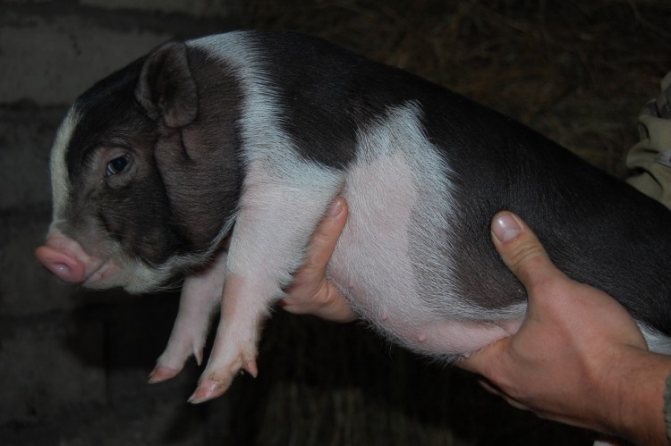

The pigs reach maturity early, a weight of 30 kg is needed, so the piglets and the pig will be healthy.
Determination of readiness for mating a pig:
- anxiety;
- swelling of the genital loop;
- discharge is possible;
- when you press down on the croup of the pig with your hands, it suddenly freezes and stops.


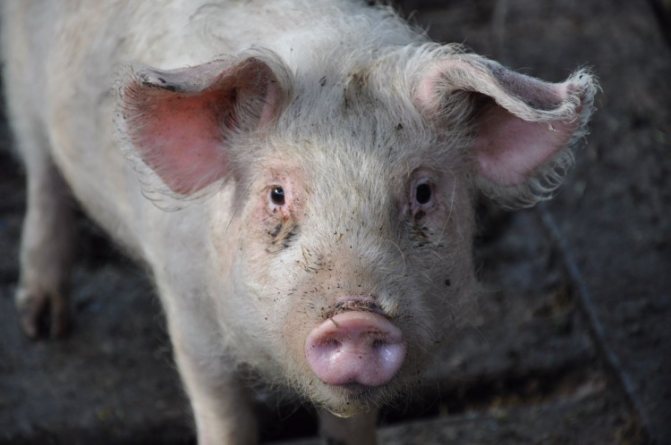

African swine fever: symptoms, quarantine regime, prevention and control of the disease (120 photos and videos)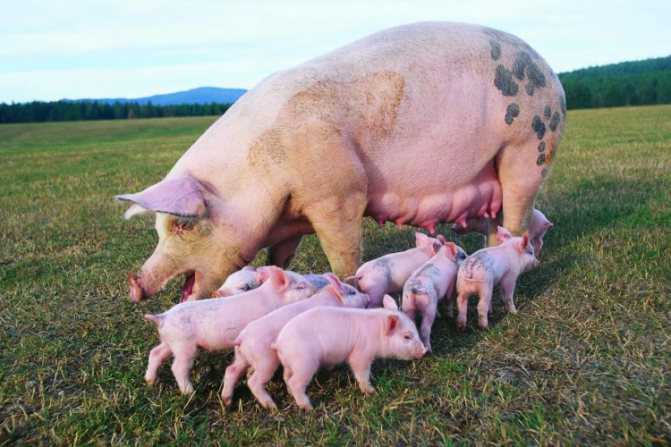

Sow - features of keeping, feeding, secrets of raising healthy pigs and keeping their offspring (110 photos)
- Pig diseases: 130 photos of symptoms, treatment videos and veterinarian advice on preventing the most dangerous diseases
To ensure mating, you need to place the boar with the pigs for a day.
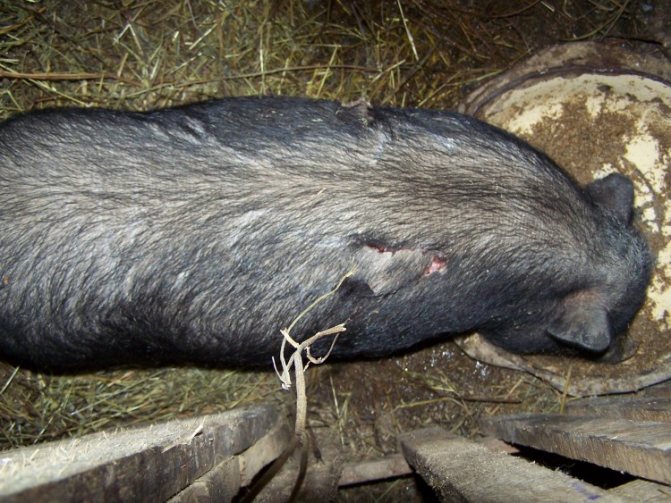

Pregnancy lasts 115-118 days, the pig crushes hay for the nest a week before farrowing, worries.


In the pig, the milk lobes increase, the nipples turn red, and the belly sinks to the ground. On the day of farrowing, the pigs do not want to eat, and droplets of clear colostrum will come out of the nipples.


A newborn pig is cleaned of films (mucus), the umbilical cord is cut off, and the wound is lubricated with iodine. For kids it is necessary: warmth + 30-32o С, clean water and fragrant fresh hay.



